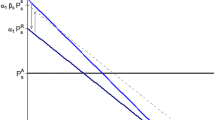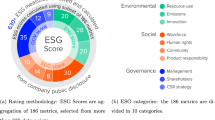Abstract
A Monte Carlo procedure is used to demonstrate the dangers of basing (farm) risk programming on only a few states of nature and to study the impact of applying alternative risk programming methods. Two risk programming formulations are considered, namely mean-variance (E,V) programming and utility efficient (UE) programming. For the particular example of a Norwegian mixed livestock and crop farm, the programming solution is unstable with few states, although the cost of picking a sub-optimal plan declines with increases in number of states. Comparing the E,V results with the UE results shows that there were few discrepancies between the two and the differences which do occur are mainly trivial, thus both methods gave unreliable results in cases with small samples.
Article PDF
Similar content being viewed by others
Avoid common mistakes on your manuscript.
References
Ames, G. C. W., Reid, D. W., & Hsiou, L. F. (1993). Risk analysis of new maize technology in Zaire: a portfolio approach. Agricultural Economics, 9, 203–214.
Anderson, J. R., Dillon, J. L., & Hardaker, J. B. (1977). Agricultural decision analysis. Ames: Iowa State University Press.
Atwood, J., Shaik, S., & Watts, M. (2003). Are crop yields normally distributed? A re-examination. American Journal of Agricultural Economics, 85, 888–901.
Bhende, M. J., & Venkataram, J. V. (1994). Impact of diversification on household income and risk: a whole-farm modelling approach. Agricultural Systems, 44, 301–312.
Chalfant, J. A., Collender, R. N., & Subramanian, S. (1990). The mean and variance of the mean-variance decision rule. American Journal of Agricultural Economics, 72, 966–974.
Clemen, R. T., & Reilly, T. (1999). Correlation and copulas for decision and risk analysis. Management Science, 45, 208–224.
Collender, R. N. (1989). Estimation risk in farm planning under uncertainty. American Journal of Agricultural Economics, 71, 996–1002.
Dorward, A. (1999). A risk programming approach for analysing contractual choice in the presence of transaction costs. European Review of Agriculture Economics, 26, 479–492.
Epplin, F. M., & Al-Sakkaf, G. A. (1995). Risk-efficient tillage systems and program participation strategies for land subject to conservation compliance. Review of Agricultural Economics, 17, 311–321.
Fackler, P. L. (1991). Modeling interdependence: an approach to simulation and elicitation. American Journal of Agricultural Economics, 73, 1091–1097.
Flaten, O., & Lien, G. (2007). Stochastic utility-efficient programming of organic dairy farms. European Journal of Operational Research, 181, 1574–1583.
Freund, R. J. (1956). The introduction of risk into a programming model. Econometrica, 24, 253–263.
Hardaker, J. B., Huirne, R. B. M., Anderson, J. R., & Lien, G. (2004). Coping with risk in agriculture, 2nd edn. Wallingford: CABI Publishing.
Hardaker, J. B., Lien, G., & Richardson, J. W. (2007). Expanding the states of nature for risk programming. Contributed paper to the Australian Agricultural and Resource Economics Society’s 51st Annual Conference, Queenstown, New Zealand, February 13–15, 2007.
Hazell, P. B. R. (1971). A linear alternative to quadratic and semivariance programming or farm planning under uncertainty. American Journal of Agricultural Economics, 53, 53–62.
Just, R. E., & Weninger, Q. (1999). Are crop yields normally distributed? American Journal of Agricultural Economics, 81, 287–304.
Kennedy, J. O. S., & Ng, G. P. (1978). Alternative measures of variance in risk programming models. European Review of Agricultural Economics, 5, 5–20.
Kobzar, O. A., van Asseldonk, M. A. P. M., & Huirne, R. B. M. (2005). Whole-farm planning under risk: Application of alternative risk programming techniques to support portfolio decisions in Dutch agriculture. In Agricultural economics society annual conference, University of Nottingham, England.
Krause, M. A., Deuson, R. R., Baker, T. G., Preckel, P. V., Lowenberg-DeBoer, J., Reddy, K. C., & Maliki, K. (1990). Risk sharing versus low-cost credit systems for international development. American Journal of Agricultural Economics, 72, 911–922.
Lambert, D. K., & McCarl, B. A. (1985). Risk modeling using direct solution of nonlinear approximations of the utility function. American Journal of Agricultural Economics, 67, 846–852.
Lence, S. H., & Hayes, D. J. (1995). Land allocation in the presence of estimation risk. Journal of Agricultural and Resource Economics, 20, 49–63.
Lien, G., & Hardaker, J. B. (2001). Whole-farm planning under uncertainty: impacts of subsidy scheme and utility function on portfolio choice in Norwegian agriculture. European Review of Agricultural Economics, 28, 17–36.
Markowitz, H. (1952). Portfolio selection. Journal of Finance, 7, 77–91.
NILF (2005). Handbok for driftsplanlegging [Handbook in farm business planning] 2005/2006. Oslo: Norwegian Agricultural Economics Research Institute.
Olson, K. D., & Eidman, V. R. (1992). A farmer’s choice of weed control method and the impacts of policy and risk. Review of Agricultural Economics, 14, 125–137.
Pannell, D. J. (2006). Flat earth economics: The far-reaching consequences of flat payoff functions in economic decision making. Review of Agricultural Economics, 28, 553–566.
Pannell, D. J., & Nordblom, T. J. (1998). Impacts of risk aversion on whole-farm management in Syria. Australian Journal of Agricultural and Resource Economics, 42, 227–247.
Patten, L. H., Hardaker, J. B., & Pannell, D. J. (1988). Utility-efficient programming for whole-farm planning. Australian Journal of Agricultural Economics, 32, 88–97.
Richardson, J. W., Klose, S. L., & Gray, A. W. (2000). An applied procedure for estimating and simulating multivariate empirical (MVE) probability distributions in farm-level risk assessment and policy analysis. Journal of Agricultural and Applied Economics, 32, 299–315.
Richardson, J. W., Lien, G., & Hardaker, J. B. (2006). Simulating multivariate distributions with sparse data: a kernel density smoothing procedure. Poster paper contributed to the 26th International Conference of Agricultural Economics, Gold Cost, Australia, August 12–18, 2006.
Romero, C. (2000). Risk programming for agricultural resource allocation: a multidimensional risk approach. Annals of Operations Research, 94, 57–68.
Schlaifer, R. (1959). Probability and statistics for business decisions. New York: McGraw-Hill.
Tauer, L. W. (1983). Target MOTAD. American Journal of Agricultural Economics, 65, 608–610.
Torkamani, J. (2005). Using a whole-farm modelling approach to assess prospective technologies under uncertainty. Agricultural Systems, 85, 138–154.
Author information
Authors and Affiliations
Corresponding author
Rights and permissions
Open Access This is an open access article distributed under the terms of the Creative Commons Attribution Noncommercial License (https://creativecommons.org/licenses/by-nc/2.0), which permits any noncommercial use, distribution, and reproduction in any medium, provided the original author(s) and source are credited.
About this article
Cite this article
Lien, G., Hardaker, J.B., van Asseldonk, M.A.P.M. et al. Risk programming analysis with imperfect information. Ann Oper Res 190, 311–323 (2011). https://doi.org/10.1007/s10479-009-0555-y
Published:
Issue Date:
DOI: https://doi.org/10.1007/s10479-009-0555-y




